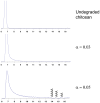Production of chitooligosaccharides and their potential applications in medicine
- PMID: 20559485
- PMCID: PMC2885077
- DOI: 10.3390/md8051482
Production of chitooligosaccharides and their potential applications in medicine
Abstract
Chitooligosaccharides (CHOS) are homo- or heterooligomers of N-acetylglucosamine and D-glucosamine. CHOS can be produced using chitin or chitosan as a starting material, using enzymatic conversions, chemical methods or combinations thereof. Production of well-defined CHOS-mixtures, or even pure CHOS, is of great interest since these oligosaccharides are thought to have several interesting bioactivities. Understanding the mechanisms underlying these bioactivities is of major importance. However, so far in-depth knowledge on the mode-of-action of CHOS is scarce, one major reason being that most published studies are done with badly characterized heterogeneous mixtures of CHOS. Production of CHOS that are well-defined in terms of length, degree of N-acetylation, and sequence is not straightforward. Here we provide an overview of techniques that may be used to produce and characterize reasonably well-defined CHOS fractions. We also present possible medical applications of CHOS, including tumor growth inhibition and inhibition of T(H)2-induced inflammation in asthma, as well as use as a bone-strengthener in osteoporosis, a vector for gene delivery, an antibacterial agent, an antifungal agent, an anti-malaria agent, or a hemostatic agent in wound-dressings. By using well-defined CHOS-mixtures it will become possible to obtain a better understanding of the mechanisms underlying these bioactivities.
Keywords: application; chitinase; chitooligosaccharide (CHOS); chitosan; chitosanase.
Figures









References
-
- Minke R, Blackwell J. The structure of alpha-chitin. J Mol Biol. 1978;120:167–181. - PubMed
-
- Gardner KH, Blackwell J. Refinement of structure of beta-chitin. Biopolymers. 1975;14:1581–1595. - PubMed
-
- Bhatnagar A, Sillanpää M. Applications of chitin- and chitosan-derivatives for the detoxification of water and wastewater - A short review. Adv Colloid Interface Sci. 2009;152:26–38. - PubMed
-
- Dodane V, Vilivalam VD. Pharmaceutical applications of chitosan. Pharm Sci Tech Today. 1998;1:246–253.
-
- Harish Prashanth KV, Tharanathan RN. Chitin/chitosan: modifications and their unlimited application potential -an overview. Trends Food Sci Technol. 2007;18:117–131.
Publication types
MeSH terms
Substances
LinkOut - more resources
Full Text Sources
Other Literature Sources
